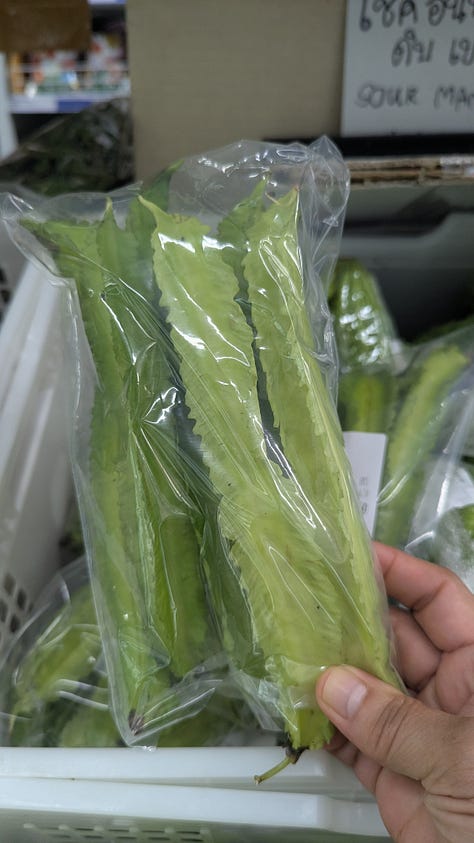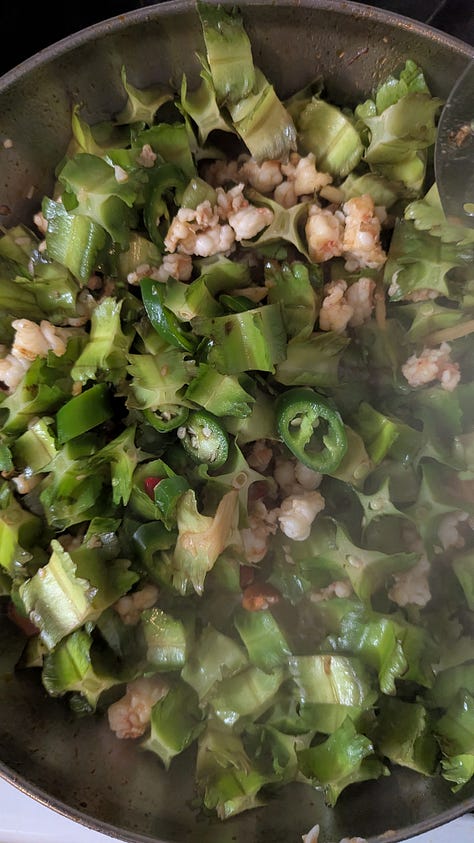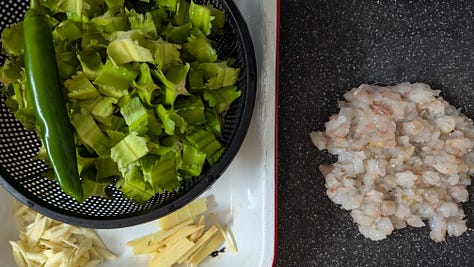Wake up, wake up! That is the literal translation of this dish, a spicy slap in the face at the first spoonful.
Say hello to Gising Gising! A dish popular amongst Filipino homes along the central to south Luzon region of the Philippines, made with sigarilyas - winged bean in the English language.
Sigarilyas or winged beans thrive in tropical humid climates and they are prominent in Southeast Asian countries - Philippines, Malaysia, Thailand to Myanmar. The pod has the distinctive four-sided winged shape which is where the name comes from. They are also known as goa bean or four-angled beans. In Laguna and Quezon they are called kalamismis.
While the popularity of sigarilyas is comparable to sibuyas (onions), kamatis (tomatoes), singkamas (jicama) and talong (eggplant), this is only because of the old Filipino nursery rhyme/song Bahay Kubo* where this vegetable is mentioned. Not many Filipinos are familiar with this vegetable.
To be honest, I only first ate this a couple of years ago, when my Tita Dulce (bless her soul) cooked this dish when we were visiting. Traditionally it is cooked with pork mince and lots of chillies - which is the spicy slap that wakes you up. As they are seasonal, some restaurants in Manila with gising gising in their menu use regular beans.
Another interesting fact is that in Nueva Ecija, central part of Luzon, the gising gising dish is entirely, completely different from this version. The Nueva Ecija gising gising is a dish of seafood (prawns, squid, mussels) and various vegetables. The only common thing is both dishes are packed full of chillies. There is only one restaurant in Sydney that serves this dish and I can tell you it is spicy AF!
A bit of botanical nuance about this vegetable is that while it is called winged bean, the vegetable is really also classified as a pod which is eaten with the immature beans.
This is my lenten/vegetarian/seafood version of gising-gising, using chopped prawns.
I am on a meatless for lent challenge and to make it more fun and exciting in this space, I’ll be sharing Filipino classic dishes that are fish and vegetable based to show a wider audience that our cuisine is not just about the sisig, adobo and lechon!



Ingredients
3-5 cloves garlic, finely chopped
1 ginger (approximately 2 thumb size pieces), finely chopped
300-500 grams prawns, peeled and chopped (save the heads!)
2 bunches winged beans* (approximately 280-350 grams), sliced (removing tops and tail)
1 400-ml coconut milk
1 long green chilli (jalapeno), sliced
3-5 pieces bird’s eye chillies (red)
1 tablespoon shrimp paste**
1 teaspoon chilli sauce (optional)
2 tablespoons cooking oil (neutral oils like canola or sunflower oil)
Method
In a shallow pan, medium heat, add the oil then add the prawn heads. Cooking the prawn heads in oil will add that extra flavour into the dish. Cook until crisp, about 3-5 minutes. You can opt to discard the heads or eat them by removing the hard shell and munching on the crispy but soft inner head.
In the same pan, add the ginger and garlic, cook until soft.
Then add the chopped prawns, cook until the colours just slightly change to its orange hues. Remove from the pan and set aside.
Add the winged bean and stir with a spatula to cook and coat the beans with the oil.
Add the coconut milk, stir and bring to a boil. Add the cooked prawns and the chillies into the pan, place the lid on and bring it to a low simmer for 15-20 minutes. The coconut sauce will be slightly reduced.
Add extra fresh chillies on top and turn off the heat.
Best eaten with rice.
NOTES:
Winged beans are seasonal. If unavailable where you are, you can substitute winged beans with regular beans, chopped into small pieces.
Shrimp paste is available in many Asian or Filipino grocers.
We had this the other week - the girls skipped on this one as it is TOO HOT. Hubby in between mouthful kept saying ANGHANG (too spicy/too hot) but kept eating anyway! The prawns in this dish made elevated the regular gising-gising to a new level!
* Bahay Kubo is a well loved Philippine nursery song/rhyme which EVERY Filipino child learned growing up. Bahay Kubo is the traditional Filipino house made of bamboo with a roof of nipa leaves, and the song is about the different vegetables growing around it. If you have young kids, you would have seen this song make it to mainstream children’s show The Wiggles, performed by Purple Wiggle John and his mother Flor! Enjoy!






Ahh gising gising pala tawag dito? Matagal na akong nagluluto nito pero ang sinisigaw ko sa bahay namin "Oh luto na ang ginataang sigarilyas!". Siguro dahil hindi ako naglalagay ng siling pula, minsan yung green lang na siling pang-sigang dahil mahina kami sa maanghang na pagkain (Manilenyo stereotype, ahahha biro lamang).
Mabuhay!
I’ve never seen sigarilyas cooked with chili peppers before!